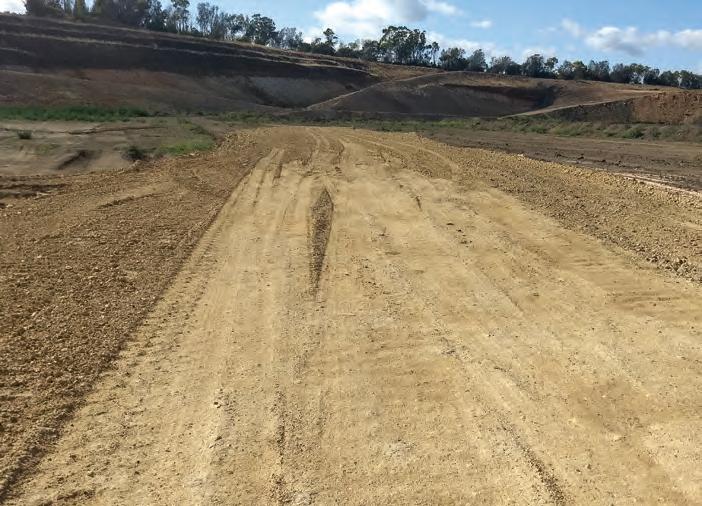
4 minute read
The building blocks of progress
PGH BRICKS & PAVERS IS TAKING A SUSTAINABLE APPROACH TO BRICK MANUFACTURING, REUSING CLAY SOURCED FROM METRO TUNNEL’S PARKVILLE STATION.
Clay material from Melbourne’s Metro Tunnel Parkville Station is estimated to weigh around 1.2 million tonnes.
With the new Metro Tunnel expected to be ready by 2025, Parkville Station forms one piece of a significant puzzle that includes new stations and tunnel entrances at Kensington, North Melbourne, Parkville, Melbourne CBD, Domain precincts, South Yarra and West Footscray.
Regular industry practice would see that material sent to landfill, but in the case of Parkville, a sustainable alternative has been developed that will see PGH Bricks & Pavers use the clay to create over 10 million bricks.
Formed in 1958, after a merger between Hanson Consolidated Industries and Maxwell Porter & David Galbraith, PGH has grown to become one of Australia’s largest clay brick manufacturers.
Work began at the Parkville site 14 January below Grattan Street, between Leicester Street and Royal Parade.
Reusing clay material has obvious environmental benefits, but it will also take pressure off PGH’s main Thomastown quarry.
As with all natural resources, at some point the clay runs dry. This forced the business to move to a new site, uprooting an established workforce, hindering businesses that work around the facility and creating rebuild costs.
Andrew Peachey, PGH’s General Manager, says projects like this help to secure Australia’s manufacturing capability into the long term.
“Normally we would extract this clay from our own quarry, so recycling material from construction sites also serves to provide longevity at our facility and continuity of work for everyone employed there,” Mr. Peachey says
Ten million bricks from the Metro Tunnel saves 10 million bricks from the quarry and this safeguards the site into the future.
“The longer we can stay at our existing facility is obviously good for builders because it keeps costs down for them. It also means we don’t have to go further out of Melbourne,” he says.
“If we ran out of resources and couldn’t get anything at Thomastown, eventually we would be moving 10, 20, 30 or 50 kilometres out of Melbourne.”
With the majority of construction in Melbourne happening in growth corridors in the north and the west, close to the Thomastown manufacturing facility, it’s in PGH’s best interests to keep the quarry maintainable for as long as possible.
Mr. Peachey says that it’s fundamental to the sustainability of Australian manufacturing.
Parkville is not the company’s first foray into material recycling PGH took clay from Blackburn railway station during the underpass redevelopment and has used sandstone from various NSW infrastructure projects.
It also has a history of using crushed bricks in mixes.
Mr. Peachey highlights the importance of the project by citing concerns that greenfield sites are being built on potentially clay-rich areas, thereby sterilising resources.
“The ability to get quality material from a large infrastructure project is quite important to the company,” he says.
The mining process can be broken down to three stages. Stage one is a traditional mine, straight down with the use of station boxes.
PGH National Raw Materials Manager Joe Gauci cites this as his preferred method, as material can be monitored more effectively, ensuring the best quality possible.
Stages two and three, which are still to be tendered, will use a tunnel boring machine. Mr. Gauci says PGH will have to wait and see who wins those jobs before assessing the suitability of the material.
PGH, working through a contractor, has been in the planning process for roughly 18
months and has started moving material to its main facility.
After geo-testing, the clay will be moved to the company’s largest mixer, where it will be combined with other materials to create an environmentally sustainable batch of bricks.
These will be sold to builders ranging from volume groups like Dennis Family, AHB Sheridon and Burbank Homes, to medium and small builders, who will use them to build predominantly residential properties.
The wider Metro Tunnel project will include two nine-kilometre tunnels running from South Kensington to South Yarra, and see the creation of five new underground stations, Arden, Parkville, CBD North, CBD South and Domain.
The sheer volume of clay material being moved by the project highlights the significance of material recycle initiatives like PGH’s and has also opened vast opportunities for the company.
“I’ve had that many calls coming in from different people. All of a sudden we’re getting a lot more interest, people coming
Reusing clay material is also taking pressure off PGH’s main Thomastown quarry.
to us saying, ‘we never knew you guys used this sort of material’,” Mr. Gauci says.
Mr. Peachey says the experience would make the company more proactive about finding infrastructure projects to partner

with in the future.
“Everything gets evaluated on a case by case basis – it’s got to go through the stringent controls of our laboratory first, but it’s opened a lot of doors.”
10th Annual Queensland Transport Infrastructure Conference 2019
18 - 19 JUNE
Brisbane Convention & Exhibition Centre
Townsville Channel Capacity Upgrade Project
Pacific Motorway M1 upgrade Mudgeeraba to Varsity Lakes Project Address by the Department of Transport and Main Roads
Project LIFT: Gold Coast Airport Major Development Plan Queensland’s Electric Vehicle Strategy

Cross River Rail – Keeping Southeast Queensland Moving










